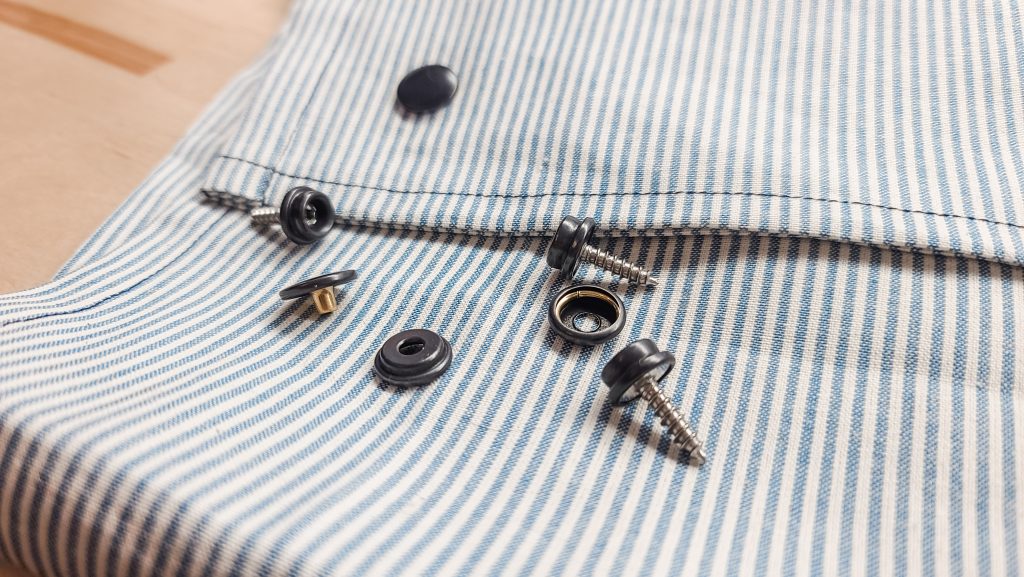
Snaps are versatile and user-friendly fasteners suitable for a variety of fabric projects. Whether you’re working with small items like curtains to larger ones like canvas or sailcloth they are the perfect addition. Incorporating snaps into your fabric is a straightforward process that can be accomplished in a few easy steps. In this blog post, I’ll guide you through the process of how to attach snaps to cloth, so you can repair items or create durable, functional, and stylish projects that are unique to you.
The benefits of using snaps

Snaps provide a versatile and convenient solution for projects involving the attachment of fabric or cloth to other materials. They provide a secure and durable fastening option that you can easily open and close, making it ideal for DIY projects such as these roll-up curtains that I made for our skoolie. Using snaps eliminates the need for sewing or other permanent fastening methods, allowing for greater flexibility in design and the ability to change or modify the project as desired.
Wide application
In addition, snaps are also an effective tool for securing items in an RV, skoolie, or boat. This specific snap kit allows you to attach items directly to hard surfaces, providing a simple solution for keeping everything in place during transit.
Durable and Reliable
This snap kit is made of high-quality stainless steel and is designed to be rust-resistant in saltwater environments. This guarantees that the snaps in this kit will last for a long time, providing you with reliable performance.
Functional and Stylish Design
Snaps not only offer a functional fastening solution but also bring a touch of style to your projects. With their professional appearance, they are ideal for use in creating stylish home decor pieces or adding a finishing touch to functional items like roll-up curtains. Additionally, with their cost-effective nature, snaps are a practical choice for your projects.
What you need:

Parts of a snap

Snaps provide a versatile solution for joining various materials. A unique aspect of this specific snap set is the modified screw that allows it to securely attach material to a hard surface.
The screw of the snap set features a pointed design and is made of metal, which makes it suitable for insertion into durable materials such as wood. The screw is attached to a stud to provide stability and a point for the other portion of the snap to attach to. Next, you have the socket which is a hollow metal piece that fits over the screw and stud, holding them in place. Finally, the cap serves as the finishing touch, covering and protecting the socket while adding a polished look. These three parts work seamlessly to create a reliable fastening solution that is easy to attach and remove as needed.
How to attach snaps to fabric
Step 1: Prepare your materials

To ensure a successful snap installation, it’s important to gather all the necessary materials and tools. Before proceeding, I recommend that you practice on a scrap piece of material to gain confidence in the process. With your materials and tools at hand, you’re ready to move on to the next steps and attach the snaps to your desired material.
Step 2: Mark the placement

Before installing the snaps, determine where to place them on your material. To do this, use a pencil or fabric pen to clearly mark the desired location for each snap. This step guarantees the correct placement of your snaps for a clean and professional-looking finish.
Step 3: Make a precise hole

Using a sharp tool such as a fabric punch or the tip of a pair of scissors, create a small, precise hole in the fabric where you marked the snap location. Ensure that the hole is as small as possible so that the snap stays securely in place.
Step 4: Insert the cap

Insert the cap into the small hole made in the previous step. Ensure proper alignment with the marked location.
Also, note which side of the material to insert the cap on as it determines the visible side when the snap installation finishes. By inserting the cap correctly, you’ll achieve a finished look that meets your desired appearance.
Step 5: Apply the socket

Holding the cap in place, carefully slide the socket onto the tip of the cap. Orient the socket correctly so it will properly snap or adhere to the stud and screw. By following this step accurately, you’ll guarantee a secure and functional snap connection.
Step 6: Clamp the socket and cap together

Finalize the snap installation by clamping the socket and cap together. Use snap pliers for this step, making sure to follow the instructions provided with the pliers to ensure proper usage. By clamping the socket and cap together, you’ll ensure a strong and secure connection for your material.
Step 7: Check for stability

Ensure the snap is securely fastened by gently pulling on the fabric pieces. If necessary, reapply the setting tool to reinforce the snap.
Step 8: Repeat the process

Repeat the steps for each snap you want to install in your project.
Step 9: Insert the screw

With the snaps securely in place on your material, it’s time to attach the matching screws to the hard surface (such as wood). Insert the screws in the proper location to complete the snap assembly.
Step 10: Attach your fabric

Attach the snap onto the stud to secure the fabric in place.
In conclusion, attaching snaps to fabric is a simple and effective way to add a functional and stylish touch to your DIY projects. Whether you’re creating roll-up curtains, attaching fabric to other materials, or simply need a versatile fastening solution, snaps offer a cost-effective and practical choice. With the right tools and a few basic steps, anyone can easily install snaps and add a professional-looking finish to their projects. So, go ahead and give it a try! Your next DIY project is sure to be a success with the addition of snaps.
Looking for more inspiration? Make sure to check out more DIY below!
- DIY roll-up curtains for RV’s and skoolies
- School Bus Conversion
- DIY triple bunk beds
- DIY mercury glass mirrors

XO,
Morgan




Comments are closed.